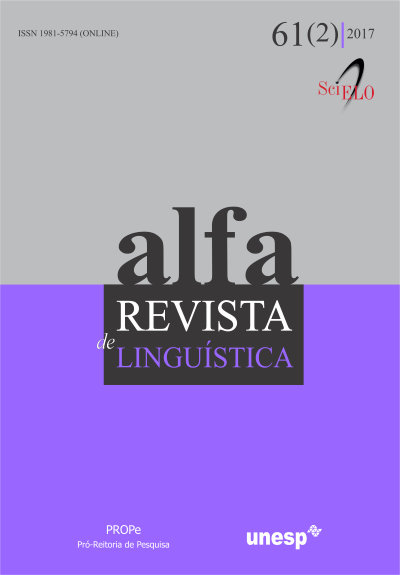Paralisia cerebral: efeitos da escrita sobre a escrita
DOI:
https://doi.org/10.1590/1981-5794-1709-4Palavras-chave:
Paralisia cerebral, Linguagem, Aquisição da escrita, Comunicação alternativa, Símbolos Bliss,Resumo
Buscamos apreender efeitos da leitura de textos na escrita de uma criança, designada como S., impedida de oralizar e escrever de próprio punho por apresentar Paralisia Cerebral. Mediante dificuldades de S. na leitura, relatadas pela professora, uma atividade semanal foi proposta pela fonoaudióloga na sala de aula da escola-clínica que S. frequentava, a partir de livro de Eva Furnari, resultando em uma produção expressiva de textos pela criança. A essas produções somam-se transcrições de filmagens em que esses textos foram lidos, que compõem o corpus alocado no banco de dados do Grupo NALingua-CNPq. Tais dados foram analisados com base em Borges (2006) que propõe a alfabetização de crianças baseada na imersão em leituras de textos diversos. Os resultados apontam para um processo de aquisição da leitura e escrita peculiar, em que cruzamentos entre símbolos/escrita e escrita/escrita operam a leitura da criança. Suas produções trazem efeitos dos textos matriz, lidos em um jogo de espelhos que revelam o funcionamento da língua e, ao mesmo tempo, diferenças: marcas de um sujeito em sua singularidade. Mudanças objetivas e subjetivas na assunção de abordagem teórica diversa da do professor pelo fonoaudiólogo resultaram em mudanças objetivas e subjetivas na relação de S. com a escrita.Downloads
Não há dados estatísticos.
Downloads
Publicado
01/09/2017
Como Citar
VASCONCELLOS, R.; DEL RÉ, A. Paralisia cerebral: efeitos da escrita sobre a escrita. ALFA: Revista de Linguística, São Paulo, v. 61, n. 2, 2017. DOI: 10.1590/1981-5794-1709-4. Disponível em: https://periodicos.fclar.unesp.br/alfa/article/view/8617. Acesso em: 6 dez. 2025.
Edição
Seção
Artigos Originais
Licença
Os manuscritos aceitos e publicados são de propriedade da Alfa: Revista de Linguística. É vedada a submissão integral ou parcial do manuscrito a qualquer outro periódico. A responsabilidade do conteúdo dos artigos é exclusiva dos autores. É vedada a tradução para outro idioma sem a autorização escrita do Editor ouvida a Comissão Editorial.

